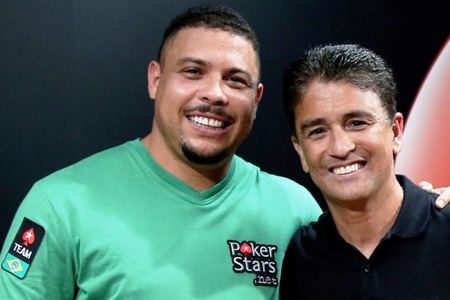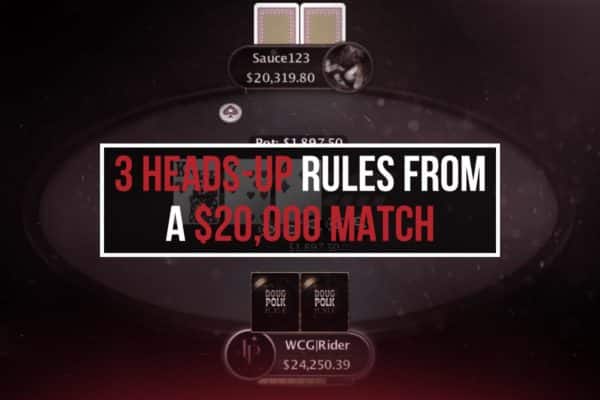Poker Tournament Heads Up Rules
- Heads-Up Sit & Go’s kick off when a set number of players have registered (i.e. 2, 4, 8, etc.).Head’s Up Multi-Table Tournaments have no late registration and will start – depending on the poker website / venue – with either an even number of players (2, 4, 8, 16, 32, etc.) or an odd number of players, giving some players a first-round “bye.”.
- You’ll learn how two of the best heads-up tournament players think through every decision in more than 600 hands as they battle their way to the final round in the prestigious NBC Heads-Up Championship. You’ll see their cards and hear their thoughts through twelve matches as they devise masterful strategies to defeat world-class opponents.
- Different types of tournaments - eg Bounty Tournaments, Heads-Up Tournaments, Freezeout Poker Tournaments - will all have different rules variations as well so it's critical to know exactly what type of tournament you're playing in. Here are some of the most standard rules that will apply when paying most Texas Holdem tournaments.
A heads-up tournament consists of tables with two players per table. The players on each table play against each other (heads up) until a there is a winner. The winners then progress to further rounds to play more games until there is an overall winner. The player who does not have the button is dealt the first playing card. Heads-Up Tournament An occasional Heads-Up Tournament always provides a nice change of pace for players and allows for quite a bit of tournament director discretion regarding how it is run. The basic premise is quite simple. Players play heads-up matches against each other. The format you can use to run the heads-up tournament are quite varied.
Heads up poker is a form of poker that is played between only two players. It might be played during a larger cash game session, where the game is breaking up and only two players remain on the table, or where two players are trying to start a game and playing heads-up while waiting for other opponents. It is also a necessary phase in most sit-and-go (SNG) poker tournaments; the single remaining tournament winner will at some point have to face only a single opponent. Alternatively, heads up poker may be played on purpose, either in a cash game format, or as a SNG, where two players play a winner-take-all tournament for a fixed, previously agreed upon amount of money. On larger online poker rooms and during certain tournament series, one may stumble upon larger heads up tournaments, usually in the shoot-out format. Usually, in order to ensure the fairness of the game, all players finishing at the same level of the tournament bracket will be paid out the same amount of money, no matter what their finishing place is.
Strategy[edit]
The rules of heads up poker are the same as in a game with three or more players, except in community card poker, the blinds are usually reversed in order to decrease the positional advantage in matches between two players of similar skill. Nevertheless, the strategy employed tends to be vastly different from a multi-handed poker game. Since only two players take part in the hand, the chance of having the best hand is much higher than in a multi-handed game, which causes the game to become more aggressive than normal. Bluffs for example become easier to pull off in a heads up game since it is only necessary to bluff a single opponent in order to win the pot, whereas in a multi-handed game there is a greater risk of someone having a big hand that cannot be bluffed.
In spite of the diversity of strategies one can design, it is important to remark that the heads-up limit Texas hold'em variation has been claimed to be 'essentially weakly solved' in January 2015 by the Cepheus poker-playing bot. Theoretically a slightly better strategy exists but would not be able to win more than one big blind per thousand games on average. A person using that strategy would not be able to prove with statistical significance that it was better than Cepheus even with a lifetime of playing against it.[1][2]
The bot can be played online at poker.srv.ualberta.ca, and users can even query strategies from the software.
Tournaments[edit]
In poker tournaments heads up poker is played as individual events and there are also heads up championships. Heads up poker tournaments are typically played as knock-out tournaments. An example of a heads up tournament is the National Heads-Up Poker Championship.
References[edit]
- ^Bowling, Michael; Burch, Neil; Johanson, Michael; Tammelin, Oskari (Jan 2015). 'Heads-up limit hold'em poker is solved'. Science. 347 (6218): 145–9. doi:10.1126/science.1259433. PMID25574016.
- ^Emily Conover (8 January 2015). 'Texas Hold 'em poker solved by computer'. Retrieved 15 January 2015.
Heads up poker is the purest form of the game and is one of the most profitable game types for skilled players.
Heads up poker format means that you will have to play the blind every hand and hence will have to play LOTS of hands - in some cases 100% of the hands you are dealt.
It's a high-pressure environment, that's for sure.
For a proficient player, this gives the opportunity to impost their skill set onto weaker opponents every single hand and can mean higher win-rates when compared to 6-max and full-ring games.
The key skill in heads up poker is the ability to adjust to your opponent and exploit them - that is what we will be covering in this article as we try to adjust to another professional player and target his leaks and weaknesses.
Adjusting Your Heads Up Strategy
A winning player's heads up poker strategy consists of a malleable game plan ready to go from the onset. Solid ranges they’ve developed that they look to adjust as new information is learned about their opponent.

Playing against a past challenger allows you pick-up where you left off in your previous encounter. Looking for ways to get an edge. Exactly what I was doing in a recent heads-up poker SNG tournament battle where I was pitted against a coach from Japanese poker site, www.pokertrainingjp.com.
I had won 2-1 in the previous bout of HU SNG’s, but Akinori issued a new challenge. He was keen for revenge since the games would be recorded for content on the Japanese poker training site.
Free MTT Poker Training:
The Underused MTT Skills Essential For Success
- 5 Day Email MTT Poker Training Course By Poker Pro Kelvin 'Acesup' Beattie
- 3 Key Skills That Will Take Your MTT Poker Game To A New Level
- 1.5 Hours Of Professional Poker Training
The key to defeating Akinori again was all in the adjustments. His style was ‘TAGish’ which leaves you particularly vulnerable in short-handed and heads-up games.
My plan was an aggressive blitz. Constant aggression allowing me to win the majority of the pots. Chipping away at him until eventually, I’d finish off his dwindling stack.
Poker Tournament Heads Up Rules 2019
This is also a very common scenario when heads-up in an MTT.
MTT poker players often lack a heads up poker skill set and are easily exploited since they aren’t used to playing the wide ranges necessary to be competitive heads-up.
Check out the video of the match and then we will discuss the strategy involved:
Heads Up Poker Strategy: Preflop Starting Ranges
I planned to open around 5% wider than I would against a tough opponent. In hindsight, I think opening 100% of hands would have been a reasonable strategy. This would allow me to exploit his tendencies to over-fold preflop, and 3bet at a low frequency. A style which was confirmed in the replay as he made some questionable folds.
Conversely, against his open raises, I didn’t plan on folding much at all.
Home Poker Tournament Rules
Versus his 2.5x open raise I was calling more than 5% wider than I would against a tougher player. The pot odds would be 2.3:1 to call. Around 30% ‘straight-up‘ equity required. When considering the all important equity realization, with some of the weakest calls in my range like 63o, I’d need to realize equity as follows;
Equity realization required = pot odds / equity = 0.3 / 0. 334 = 90%.
I was fairly confident I’d be in this vicinity given Akinori’s tendency to be a little passive post flop, especially on the later streets. This is common for a lot of ‘TAGish’ players when they get to heads-up.
They know a good strategy is to open a lot of hands preflop, but this translates to them being out of their comfort-zone on later streets when they’re frequently left with much more marginal holdings then they are used to. Typically resulting in a lot of turn and river checking.
This passivity on later streets would allow me to realize a reasonable share of my equity OOP. Again evident in the replay as some of my weaker out of position floats did get to the river where I was able to steal some nice pots (Q2, J9, etc).
Defending The Blinds Heads Up: 3betting
Part of the HU strategy to defend frequently from the big blind included 3 betting a lot.
A typical strategy might include a mix of:
- weaker suited hands,
- premium hands,
- and a mix of suited connectors mostly for board coverage protection.
All at a frequency.

Equating to around a 15-20% sort of range spread. I planned on pushing this a bit further to 20%+ by including a mix of high-low holdings (as we saw with Q2s, J4o), and some weaker combinations at a low frequency. Aiming to profit from my opponent's over folding ways.
Key Strategies To Beating Heads Up Poker
Overall the adjustments pointed out are not huge. However, they help set the tone of the match, as well as lay the foundation for post-flop play. Increased opens, more defending from the big blind including a lot of 3 betting.
This style makes it really tough for a 'TAGish' type of opponent to get into a rhythm as it keeps them constantly under pressure. Their likely response is to attempt to steal less, which has the profitable result of allowing for more walks from the big blind.
This tough preflop play is then backed up postflop with frequent cbets and barrels, as well as a good mix of raises and floats. Which will be the topic of next article as we continue this heads-up series!
What About VS Loose Heads Up Opponents?
Each type of opponent presents different challenges to overcome. Loose opponents allow you to me more patient with your offense. Reducing your bluffs whilst increasing your value bets - Since your opponent will be doing more calling.
You can 3 bet wider for value if they aren't folding to reraises preflop. Proceed post-flop by cbetting less, but look for 'thinner' value. Especially on the later streets when you have more accurately identified your opponents range.
Floating out of position which works well against tighter opponents, should be used carefully. When calling a flop cbet with a marginal hand, along with some hope of improving to the best hand, the chance to steal the pot on a later street often makes this play profitable. However loose opponents often call the river with a wide range. So bluffing in a lot of spots can be a futile play. Stick to solid holdings and contest the pot more aggressively in position.

Positional advantage offers you the opportunity to take more free cards, value bet confidently, and fire small ball bluffs. Remembers a loose opponents range will often be wide, so timely bluffs should be an important part of your strategy. Attack when their range consists of numerous weak holdings, and the board heavily favors your range. Don't push the aggression but rather look for boards that develop favorably when firing multiple bullet bluffs. Moves like this can be quite risky against a loose opponent!
Summary: Strategical adjustments made this match
Having played against my opponent previously, I'd gained a good feel for the way Akinori was playing. Overall a little too tight, in, and out of position. This provided me with an opportunity to make some adjustments to gain an edge in the match.
Starting with preflop. Raising more on the button and defending more aggressively from the big blind. Setting the tempo of the match, I kept my opponent under pressure and was clearly winning the majority of the pots. By adjusting and gaining an edge in the game, I was again able to claim a 2-1 victory in this heads up poker match.
Make sure you check out the video below for some more heads up poker strategies:
Get Access to Lesson 5.8 From the Road to Success Course which is a 45 minute video covering important heads up strategies.
Want more videos like the ones in this blog post? Check out the PokerNerve Road to Success Course where we have almost 100 videos like this to help take your game to the next level.